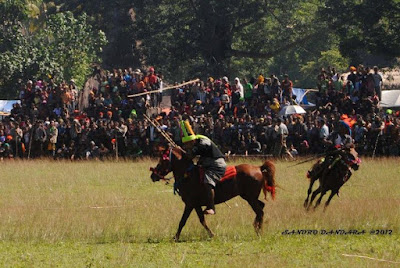 |
ancient Megalithic in Sumba
|
Southwestern Sumba show its beauty through Kampung Ratenggaro. The village is special because it is situated on a cliff on the beach Ratewoyo. Its position overlooking the sea with huge waves breaking reef. Straight ahead, no more land until we came to Africa.
The village was originally located on the headland that is located right by the beach. But the tide causing abrasion and water into the house, so the residents decided to move the village to a higher cliff.

In the former village on the beach still remains a collection of megalithic stone graves. The shape is different from the graves of stone slabs piled like in the town of Waikabubak. The tomb stones here are made of stone intact with more than two meters high and decorated with writings and ancient drawings.
Sitting next to an ancient stone tomb with a beautiful beach watching the waves crashing, I understand why so adored will Sumba cultural richness and natural beauty. Soft white sandy beach flanked by rocks and high cliffs remind me of the Tanah Lot in Bali. Of course, the beach is far more beautiful and very quiet. Unfortunately I came when cloudy so could not watch the sunset.
On the beach I met old man named Thomas who play traditional musical instruments made of wood. Excerpt dawainya add a sense of feel magical atmosphere in the place. Fatigue due to travel by bike for two hours straight loss.
The village is located in Kodi, West Sumba. Kodi is on the western tip of the island of Sumba. This place is about 80 kilometers from the city where I stay, Waikabubak. Viewed in this roadmap a little play, but this is the way the conditions are best.
This time I was escorted by a guide named Timothy Pingge, a native of Sumba. Although he says the way we passed the best condition, still we need to go through puddles and potholes road. Throughout the trip we met a group of school children who smile and friendly greeting every rider who passed them. “Afternoon mother, father day,” they said. Rain clouds hanging so many times we had to take shelter from the rain.
Rice fields, houses on the roadside with a grave stone in the yard, ravine and forest into a wonderful treat for the eyes along the journey. Before leaving, we bought a souvenir of the villagers. Rooms for the gentlemen, betel nut for the mothers and candy to the kids.
Living in such a beautiful area had little effect on the welfare of villagers. Segelitir only from those who make a living from the sea. Moreover, this village consists of only five traditional houses. Fires burned four years ago almost all houses in the village. Of the 13 houses, only one survivor.
Indigenous Villages Sumba did have a high fire risk. Roofs made of thatch flammable in the dry season. The fire spread in the wind, so the fires usually destroy all houses in the region.
Rebuilding the custom house was not cheap. Villagers told me that a house requires four main pillars to remain standing. “One timber cost the same as a buffalo, “said the occupants of the village. That’s just the cost for the main mast, not counting the cost to build the walls, floor and roof. Besides the costs, the materials are easily obtained from the original forest is now increasingly difficult to find.
Next I visited the Kampung Paronabaroro. The condition of villages in this region is different from the village that I browse in the town of Waikabubak earlier. Remote location that makes this village is still very simple. Marapu belief still held closely by its residents.
The old woman wearing a cloth. Men and women chew betel nut which makes them red saliva kesumba. This custom began in teens and make the lips look like wearing red lipstick. Horses tied to the side of the house as a symbol of social status.
The entrance to this village along a path about 4 miles. At the front of the village there is a full clearing the newer grave stone. Some have been modified by using cement, stone is no longer intact.
Grave stones with older age is located in the center of the village. The complex surrounds a grave stone altar where the conduct traditional ceremonies. Not just anyone can set foot into places that are considered sacred.
Electricity had just entered the region in late January. The power source comes from the generator fuel is filled by a joint venture with several villages in the vicinity. To save money, they only use it at night.
Source : http://amazingnotes.com







































